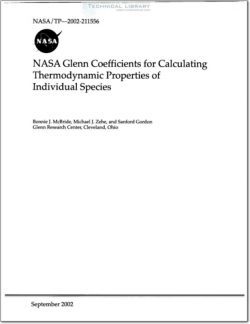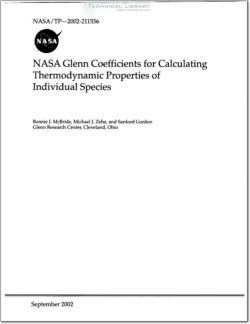NASA-TP-2002-211556

- Version
- 339 Downloads
- 19.27 MB File Size
- 1 File Count
- August 18, 2016 Create Date
- August 18, 2016 Last Updated
NASA Glenn Coefficients for Calculating Thermodynamic Properties of Individual Species

This report documents the library of thermodynamic
data used with the NASA Glenn computer program CEA
(Chemical Equilibrium with Applications). This library,
containing data for over 2000 solid, liquid, and gaseous
chemical species for temperatures ranging from 200 to
20 000 K, is available for use with other computer codes
as well. The data are expressed as least-squares coeffi-
cients to a seven-term functional form for C,?(T)/R with
integration constants for H0(7)/RT and S"(T)/R. The
NASA Glenn computer program PAC (Properties and
Coefficients) was used to calculate thermodynamic func-
tions and to generate the least-squares coefficients. PAC
input was taken from a variety of sources. A complete
listing of the database is given along with a summary of
thermodynamic properties at 0 and 298.15 K.
Thermodynamic data for individual species are
required in many applications involving chemical reac-
tions. For over 50 years the NASA Lewis (now Glenn)
Research Center has been compiling and disseminating
thermodynamic data for use in its chemical equilibrium
programs. These data, widely used by the thermody—
namic community, have grown from 42 species to the
current 2000.
For calculation purposes, the use of thermodynamic
data in the form of simple empirical equations has some
obvious advantages.First,itmakes tabularinterpolations
unnecessary; second, it permits analytical integrations;
and, third, it condenses all the tabulated information into
a few constants that accurately reproduce the many
thermodynamic data points.
Earlier versions of the NASA Lewis chemical equilib-
rium computer programs (Gordon et al., I97], Svehla
et al., I973, Gordon et al., I976, Gordon et al., 1984,
Gordon et al., I988, and McBride et al., 1994) used a
fourth—order polynomial as an empirical representation of
Cpo(T)/R over a temperature range of 300 to 5000 K.
The final library of data using this form contained I I30
species documented in NASA TM—45 I 3 (McBride et al.,
l993b). For the data in the current report, two terms
involving 7Ll and T2 were added for more accuracy over
wider temperature ranges.
| File | Action |
|---|---|
| NASA-TP-2002-211556 NASA Glenn Coefficients for Calculating Thermodynamic Properties of Individual Species.pdf | Download |
Comment On This Post